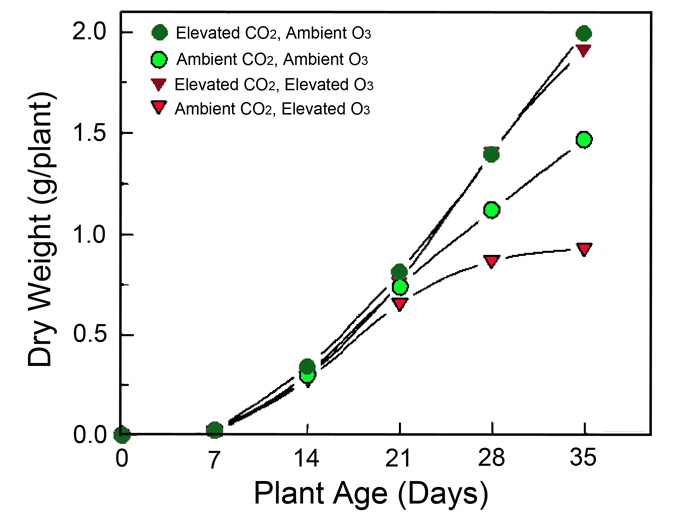| Follow @co2science |
Paper Reviewed
Rao, M.V., Hale, B.A. and Ormrod, D.P. 1995. Amelioration of ozone-induced oxidative damage in wheat plants grown under high carbon dioxide. Plant Physiology 109: 421-432.
Tropospheric ozone (O3) is a gaseous air pollutant that results from incomplete combustion of fossil fuels. It negatively affects plant growth, gaining entry through stomatal openings where it dismutates and generates reactive oxygen species that damage cell components and disturb metabolic processes.
In the future, the concentration of O3 is projected to increase significantly, resulting in more frequent and severe cell damage and in extreme cases, plant death. However, the atmospheric concentration of carbon dioxide (CO2) is also expected to rise in consequence of increased fossil fuel combustion. And because elevated CO2 enhances plant growth, there has been much interest in how these two opposing forces will play out.
Such was the interest of Rao et al. (1995), who conducted a series of experiments to investigate the interactive effects of elevated CO2 and O3 on wheat. And although their experiment was conducted over two decades ago, their findings are just as relevant today as they were the day they were obtained.
To accomplish their objective the three Canadian researchers from the Department of Horticultural Science at the University of Guelph grew wheat (Triticum aestivum L. cv Roblin) from seed in controlled environment chambers for five weeks at two O3 concentrations (4 ppb for ambient and 120 ppb for elevated) and two CO2 concentrations (390 ppm for ambient and 800 ppm for elevated). O3 exposure was provided for 8 hours per day during the photoperiod and CO2 concentrations were maintained constant throughout both the day and night. And what did this study reveal?
As expected, elevated CO2 resulted in "substantial increases in the shoot biomass of plants" (approximately 36% under ambient O3 conditions, see Figure 1), whereas elevated O3 resulted in a significant decline (approximately 34% under ambient CO2 conditions). Grown in combination, the shoot biomass of the wheat plants under elevated CO2 and elevated O3 conditions was "almost the same" as that of plants grown under high CO2 and ambient O3 conditions. In other words, the beneficial effects of elevated CO2 not only fully compensated for the dry weight loss due to elevated ozone, it completely overcame it as if this stress was never present! And driving this point home, Rao et al. write "we did not observe an adverse impact of O3 on the shoot biomass of wheat plants grown under high CO2."
In an attempt to discern why such benefits were conferred, the team of researchers also investigated the impact of these two variables on various enzymes and proteins. Such examination revealed that "prolonged O3 exposure in ambient CO2 inactivated antioxidant enzymes, whereas the activities were maintained in plants exposed to O3 in high CO2." And in consequence of these findings, Rao et al. conclude that their study provides "evidence for the role of high CO2 in maintaining an efficient antioxidant defense system upon receiving oxidative stress," which defense system, they note, may also operate in the presence of other environmental stresses, including heat shock, water deficit, UV radiation and pathogens.
In light of such experimentally-deduced observational facts, which were determined over two decades ago, it is sad that so many have ignored the very real benefits of elevated atmospheric CO2 concentrations, such as that illustrated here, and falsely labeled this life sustaining and enhancing molecule as a pollutant.

Figure 1. Weekly measurements of shoot dry weight of wheat (Triticum aestivum L. cv Roblin) grown under various combinations of CO2 (390 or 800 ppm) and O3 (4 or 120 ppb) concentrations. Adapted from Rao et al. (1995).




